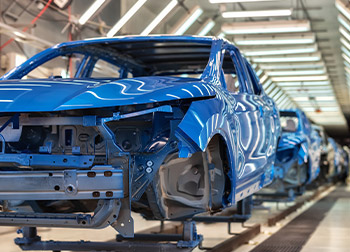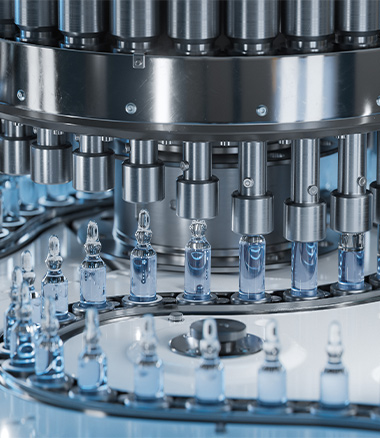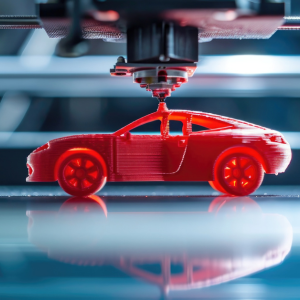2023 Manufacturing Trends
Post By: Luke West On: 11-01-2023 - Industry 4.0 - Industry Trends - Manufacturing
The global pandemic has receded to less painful horizons this year, but the changes it inspired continue to impact industrial innovation. We’re seeing more automated technologies and more AI integration. The IIoT (Industrial Internet of Things) is becoming more deeply embedded. We're getting more comfortable with remote modes of working, and changing our approach to customer relationships.
Topics that we predicted last year, in Manufacturing Trends for 2022, are still very much relevant for 2023, such as AI and ML. Techniques like 3D printing and JIT (Just-In-Time) manufacturing are also gaining traction, while old favourites like predictive maintenance are still up there. We’re looking at a much greater rate of change from B2B (business to business) transactions to B2C (business to customer) transactions, and the move to Product as a Service (PaaS). In many ways, these are all interlinked by the need to improve lead times and save energy.
Deeper Embedding Of The IIoT
The IIoT simply means applying the internet of things to Industry 4.0. It’s still a key manufacturing trend for 2023, as new use cases continue to emerge. By embedding industrial devices into their existing internet infrastructure, manufacturers are able to leverage the IIoT to make more informed, strategic decisions. You can use real-time data to fulfil a wide variety of business goals, including product innovation, improved safety and enhanced efficiency. In doing so, you can also improve lead times, and save on energy use and costs. IIoT systems have been implemented in areas such as predictive maintenance, asset management and logistics.
Part of the popularity of Industry 4.0 is due to its wide range of applications, including such areas as:
- Real-time and remote monitoring to measure and enhance overall equipment effectiveness
- Establishing parameters of normal equipment behaviour, so that abnormal activity is easily identifiable for predictive maintenance purposes
- Conducting remote analysis to pinpoint potential equipment issues before a malfunction occurs
- Real-time production monitoring to identify hidden inefficiencies in specific equipment, unit lines or operations
- Enhanced tracking using RFID and barcodes
- Running in-depth analytics such as diagnostic, predictive, descriptive and prescriptive analyses

ERP
Another 2023 manufacturing trend that’s carried over from last year is enterprise resource planning (ERP). IIoT systems can be integrated into resource management systems to improve quality of performance and HR factors such as forecasting staff requirements and recruitment. Companies will be relying more on AI and ML capabilities to provide an agile and robust response to constantly changing circumstances. Big data analysis will help to direct future planning and strategies such as streamlining processes through increased automation. Integrating more IIoT systems will help to save energy and reduce costs by providing accurate, real-time information.
Traditional methods are fast giving way to cloud-based software and management systems. To assist in modernising ERP processes, many manufacturers are rethinking their actual business needs. This can involve determining best practices and designing global templates to support those needs. Big data analytics can support ERP strategising for the future, optimising outdated processes, and streamlining for energy efficiency.
Big Data Is Growing
Manufacturers can now collect data from an ever-expanding network of sources. They can then combine that data with more deeply embedded IIoT systems and increasingly powerful analytics. This allows you to scrutinise data in all sorts of ways, giving you a much more comprehensive understanding of your business. You can make more informed decisions around production, sourcing, cost reduction and fulfilment, to name but a few. This in turn allows you to better support your growth rate strategy and push forward towards your business goals. 2023 manufacturing trends will take you past the essentials of big data collection, into discovering the real benefits of its analysis, such as intelligent supply chain management (ISC).
Addressing Supply Chain Challenges
2023 manufacturing trends are focusing on different ways to deal with the ongoing disruption of supply chains. Many issues contribute to the problem, not least climate change and geopolitical conflict. This means that more manufacturers are turning to the B2C model, cutting out wholesalers and distributors to go directly to the consumer. You save a lot of money and time by eliminating these middlemen, not to mention gaining greater control over your pricing and brand image. You can apply the same policy in reverse, by working directly with your suppliers to create a more streamlined supply chain. ISC leveraging of big data can assist with this.
Some manufacturers are even developing in-house fulfilment solutions. Instead of having a third-party logistics company carry out your deliveries, you might acquire your own logistics operation or company. Not only do you improve quality control in this way, but you also achieve greater supply chain transparency. Further, streamlining your logistics networks will save you time and money on shipping.
Reshoring
Another prominent 2023 manufacturing trend is a stronger move towards reshoring, or returning your manufacturing base to your own country. Combined with shipping and freight costs, the energy crisis is driving a large proportion of UK businesses into recession. Even those struggling to maintain a viable business are reluctant to engage in cross-border trade. In the UK, the global problems have been aggravated by Brexit and the difficulties of the Channel crossing. Several 2022 surveys suggest that almost 40% of UK manufacturers are considering reshoring as a way to keep their operations afloat. Many have already withdrawn from outsourcing operations to lower-cost producers like China or India. Instead, they’re returning to more traditional methods of manufacture, using home-grown sources.
Product As A Service
Along with the shift from B2B to B2C transaction modes, digitisation has dramatically changed consumer expectations. Rather than one-time, outright purchases, customers today only want to pay for what they’re actually using. This is a major change in customer behaviour, driven in part by the B2C ethos, and it poses some challenges for manufacturers. On the other hand, it’s also revealing new means of working and business opportunities, such as PaaS, or Product as a Service.
This is a business model where equipment is leased by manufacturers rather than sold outright. Customers may also be offered a selection of subscription-based services to add value to the proposition. In this way, you only pay for what you’re actually using, together with any value-added services you choose. PaaS allows more direct engagement between manufacturers and customers, helping end users to optimise their operations. You won’t have equipment standing around idle, and you’ll save time and energy by streamlining your usage. PaaS works for both hardware and software products, and can be worked into other systems such as lean manufacturing and the circular economy
Greater Production Efficiency With Digital Twins
Digital twins are still a fairly recent advance in the IIoT. They represent an exact virtual copy, or twin, of a physical component or piece of equipment. Operating in the virtual environment, digital twins not only look exactly the same, but work in exactly the same way. Engineers can use this virtual twin to see how it functions in any given situation or environment, and how it connects to other machines or components. Digital twins are already in use in several industry sectors, and are powerful tools that you can use to enhance many aspects of your operations, including:
- Prototyping new products or testing new production lines to accelerate speed to market
- Proactive equipment health and performance monitoring, local or remote
- Modelling and optimising production processes by identifying hidden inefficiencies
- Gauging the efficacy of repairs and improvements
- Providing hands-on training for new hires and technicians
- Modelling new business opportunities

Next-Gen Predictive Maintenance
Predictive maintenance is by no means new, but it’s still on the list for 2023 manufacturing trends. It’s starting to evolve, however, from predictive maintenance to predictive resolution. Predictive resolution analyses data to identify performance anomalies and determine root causes. It also uses the analysis to provide insights on resolving problems with greater certainty. In essence, predictive resolution improves your first-time fix rate, by increasing the chances of an issue being sufficiently dealt with on the first attempt. This means you can make your equipment even more efficient, and consequently save even more in costs.
This goal has been a long time in the works, while manufacturers built up the data history required to support predictive models. This process has now been speeded up by advancements in AI and ML, together with natural language processing (NLP). These developments enable the extraction of unstructured data from manufacturers’ text files. Documents including PDFs, Excel files and Word docs supply core data that can be converted into a format that predictive engines can use.
Aiming For Net Zero
2023 manufacturing trends see a greater focus on energy efficiency. As we struggle towards a net-zero emissions goal, finding ways to streamline production and cut down on wasted time and resources are key goals. Using products only when necessary, plus reusing components and recycling, all help to cut down waste and save energy. Reshoring and ISC help to cut shipping costs and lead times, while digital twins and 3D printing enable more tasks to be performed in-house and just in time.
Get More From Rowse Straight To Your Inbox




